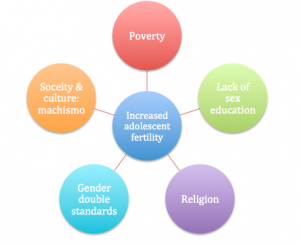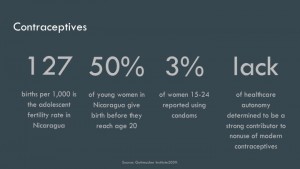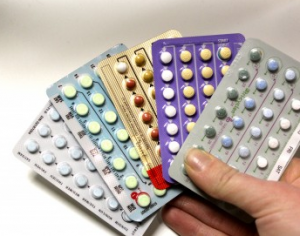Contraceptives
Overview
Every year, 13 million children are born to mothers between the ages of 15 and 19.[1] Adolescent childbearing is highly correlated with the risks of maternal morbidity and mortality, and childbearing at that age leads to an increased frequency in birth complications. The process is cyclical, as adolescent mothers have a higher risk of poverty, downward social mobility, and divorce. Nicaragua has one of the highest adolescent fertility rates in the world, and is higher than the rate for Sub-Saharan Africa as a whole with 127 births per 1,000. About 50% of Nicaraguan women give birth before the age of 20 and almost 25% of all births in the country are from adolescent women.
Factors that contribute to high rates of adolescent fertility
“Poverty and lack of opportunity are directly associated to teenage pregnancy and early motherhood, which can become impediments to women wanting to take full advantage of development opportunities,” – Luis-Felipe López-Calva, World Bank Lead Economist for Latin America and the Caribbean [2]
Poverty, politics, lack of sex education, gender double standards, religion, society and culture all contribute significantly to Nicaragua’s high adolescent fertility rate. Lack of agency for teenage women in Nicaragua results in higher rates of adolescent fertility.[3] Impoverished women have less agency in their lives due to their economic situation, and also due to their lack of education. Politically, Nicaragua is highly influenced by the Catholic Church, which makes abortion illegal in the country. Premarital sex is considered to be a sin, but there is no formal sex education in Nicaraguan schools, and pregnant girls are expelled from school. MINSA acknowledges that this is a significant issue, but fails to implement any successful policies. Socially, Nicaraguan culture is run by an idea of machismo, in which Nicaraguan men are encouraged to prove their manliness by producing many offspring, whether or not they have the means to support the offspring. Further, unofficial marriages have become popular among men, and women’s attempts to attain a marriage can be linked to having children to legitimize their relationships.[4]
Use of Contraceptives
Interestingly enough, contraceptive use among teenagers and young adults in Nicaragua is relatively high, as 70% of sexually active women between the ages of 15 and 24 report using some method contraception.[5] The wide age range of 15-24 in the study is a downfall, however, because it does not tell us the adolescent rate versus young adult rate, and the young adult rate could be obscuring the adolescent rate. [6]
In another study in 2001, only 3% of Nicaraguans between the ages of 15 and 49 reported using condoms, which is extremely low.[7] This suggests that women prefer other forms of contraceptives.
Types of Contraception
1. Condoms
2. Birth Control (pills)
3. Depo provera shot- each shot prevents pregnancy for 3 months[1]
Sources:
[1] https://www.plannedparenthood.org/learn/birth-control/birth-control-shot-depo-provera
[1] https://www.guttmacher.org/pubs/journals/3509109.html
[2] http://www.worldbank.org/en/news/press-release/2013/12/12/lac-poverty-education-teenage-pregnancy
[3] http://www.worldbank.org/en/news/press-release/2013/12/12/lac-poverty-education-teenage-pregnancy
[4] https://www.guttmacher.org/pubs/journals/3509109.html
[5] https://www.guttmacher.org/pubs/journals/3509109.html
[6] https://www.guttmacher.org/pubs/journals/3509109.html
[7] https://www.guttmacher.org/pubs/journals/3509109.html





